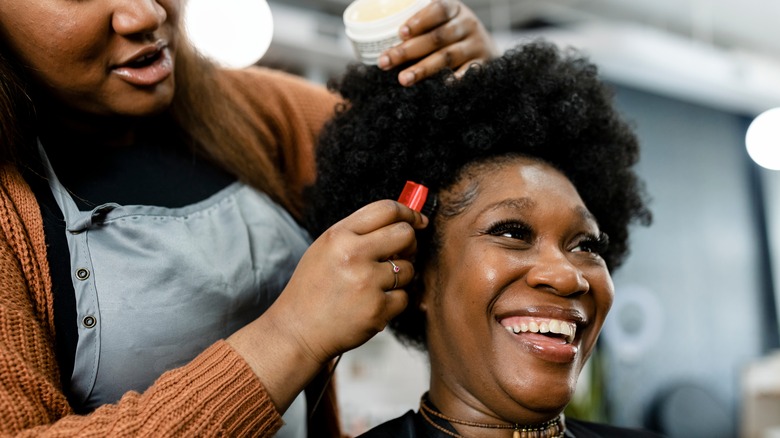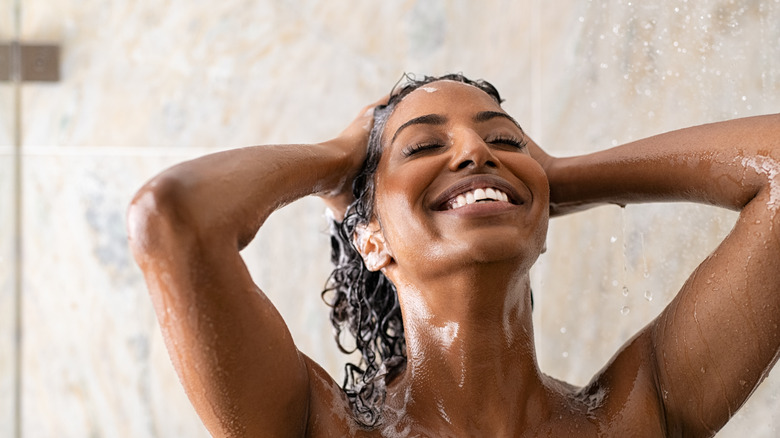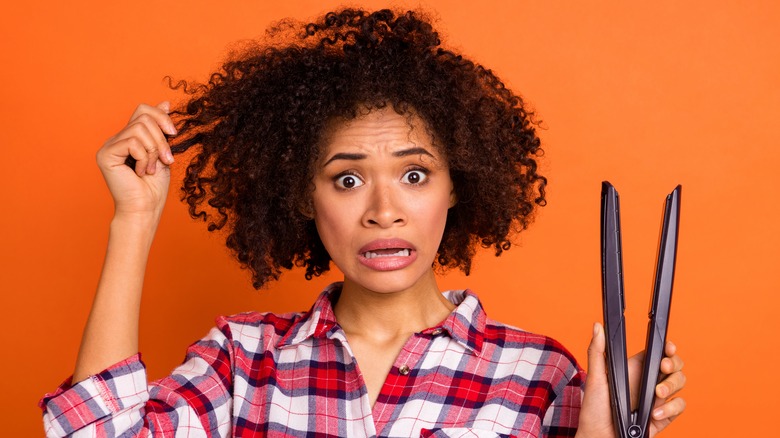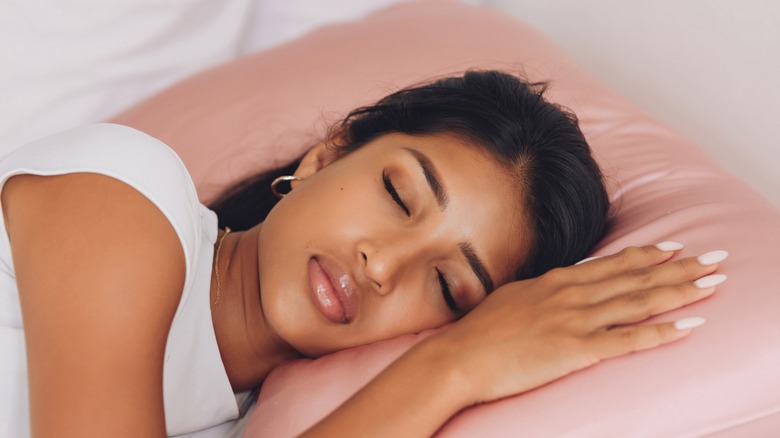Simple Tips For Keeping Your Edges Healthy
Your edges, also known as baby hairs, are shorter, often wispier, hairs that lie around your hairline, from forehead to nape. According to Luxy, they are common in women of color and have remained a part of Black culture as a fashion statement for years. Unfortunately, the position of your edges at your hairline and their thinner texture make them more vulnerable to damage when compared to the rest of your hair.
Some of the damage comes as shedding, which happens when you leave a ponytail or braids on longer than you should (per Restore). There's also the tension from tight braids or buns that pull at your scalp, relaxer burns from frequent hair straightening treatments, or the damage from the long-term use of hot hair tools. These, along with age, medication, hormonal changes, and stress, can affect hair health on all areas of your scalp, including your edges.
This damage can add up over time, thin the hair out and then cause hair loss, leaving bald patches. Sometimes the hair will grow back, but other times it won't. To avoid hair loss and damage to your edges, here are a few tips to keep your edges healthy enough for your next swoop and swirl.
Keep your edges snatched, but not literally
With every slicked-back ponytail, every new round of cornrows, and every glued-down frontal comes the risk of damaging your edges. This risk is because of a little something we call tension. Tension is the tightness with which your hair is pulled during styling, so more tension equals more uncomfortable hairdos. Healthline explains that high tension from pulling or wrapping the hair too tight causes the hair shaft to separate from the follicle, making hair more prone to falling out. An example is when your hairstylist pulls too hard when braiding or putting your hair into a bun. Pulling at hair too hard can also cause traction alopecia or hair loss caused by tightly-made hairstyles. Our advice? Keep the tension away. Your hairdo is not supposed to cause pain or make your scalp uncomfortable.
Instead, separate your edges from the rest of your hair by brushing them forward first. Then create the ponytail with the rest of your hair and use some good holding hair gel or wax to brush your edges back down on the newly made ponytail. To secure your ponytails and buns, All things Hair recommends ditching the elastic bands and using scrunchies instead. And for cornrows and braids, it's best to let your hairstylist know that you prefer they do not braid your edges in or ask them to reduce the tension in their hands. Your braids should protect your baby hairs, not compromise them.
Treat your edges to good products
Indulging in hair oils, leave-in conditioners, hair butter, and masks is an excellent way to keep hair healthy, but these products won't do much for your edges if you ignore them. It can be easy to leave out your edges while working product through the mass of your hair, but you'll need to make it a point to remember if you want healthy baby hairs. According to L'Oréal Paris, dry hair is more prone to damage and breakage, and it's the same for your edges.
NaturAll encourages you to pay extra, loving attention to your edges by gently rubbing hair oils like castor oil and rosemary oil on them. It's best to do the same while deep and leave-in conditioning by taking a small dollop of product and applying it around your hairline in circular motions.
Want more reasons to massage products onto your edges? Doing so also promotes blood circulation, a practice Cureskin says alleviates hair loss, improves hair health, and only takes five to ten minutes. All in all, it's a great, multipurpose way to maintain healthy and full baby hairs.
Put the hot tools away
Kinkier-textured edges are not the easiest to slick down, especially for those with 4C hair. They can ball up, not lay at all, or you can leave the house with them slicked down, and they'll re-emerge curly as if you never swooped them down. This is because, unlike other hair textures where the baby hairs are thinner, 4C baby hairs can be just as coarse as the rest of the hair. To achieve the desired swoop and swirl look, people have come up with several hacks, one of which is using a mini hair straightener on the edges only. But regular use of heat can damage your edges, leaving them dry and unhealthy. Hot combs, blow dryers, and flat irons used during frontal installations, for hair curling, and for installing extensions also cause damage.
However, you can still use heat when installing extensions or frontals. Instead, RevAir recommends using a good heat protectant like the Design Essentials Agave & Lavender Weightless Thermal Protectant Serum on your hair, including your edges. And for the 4C girlies, Baby Tress recommends starting with dry hair and using an extra-hold, pomade-like edge control.
Be cautious with your headgear
Your headbands, face caps, and hats usually lie on your hairline and can produce friction when they move against your edges. Friction is also generated when you use cotton pillowcases which are drying, can cause frizziness, and can snag at thin baby hairs. Thus, NaturAll advises against wearing hats and caps with ordinary linings and going for those with satin or silk linings on the area that comes in contact with your hairline. If a satin lining is unavailable, try tying your hair with a silk scarf and then wearing your hat over it. Going to bed with satin bonnets and pillowcases is also a great way to maintain healthy edges, as they protect the hair by reducing friction and retaining the hair's moisture (per Puff Cuff).
There are several ways to grow and maintain healthy edges, but as HeyCurls says, nothing beats being patient with your edges and giving them time to rest and recuperate between hairdos.




